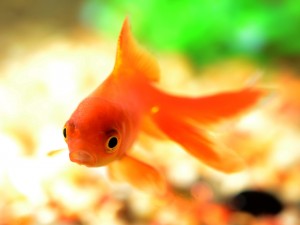 Never mind the famous thought that people have a shorter attention span than that of a goldfish. (Who measured the goldfish anyway, and how?)
Never mind the famous thought that people have a shorter attention span than that of a goldfish. (Who measured the goldfish anyway, and how?)
People pay attention when they are interested, or when it’s in their best interest. So if you’re producing articles, web copy, blog posts, marketing material and other writing, you need to capture the reader’s interest.
Do so by borrowing a technique used by novelists and feature writers: what I call expressive writing, also known as figurative writing. As Don Ranly, professor emeritus of the Missouri School of Journalism, says, “Appeal to the senses. Be specific and concrete rather than general. Don’t tell me – show me.”
Here are three ways to use expressive writing:
1. Use analogies (similes or metaphors)
Similes compare two things, using “like” or “as”:
- “Local reservoirs had shrunk, leaving a wide swath of dried mud as cracked as an alligator’s hide.” – Sue Grafton in X: Kinsey Millhone Series Book 24
- “When she woke up in the morning, the day rolled out in front of her like a long hallway for her to meander down, free to linger over the best parts.” – Liane Moriarty in What Alice Forgot
Metaphors compare the unfamiliar to the familiar without using “like” or “as”:
- “Harper was the size of a cell phone when she was born two years ago… The baby was deemed a ‘micro-preemie;’ she weighed as much as a can of soup.” – Mike Hixenbaugh, David Hunn, Mark Collette in The Houston Chronicle
- “Using a laser beam capable of detecting very small motions in the bees’ hairs…they found that the fuzzy strands bent in response to the electric fields, much the same way human hair will stand up when mussed with a balloon.” – Sarah Kaplan in The Washington Post
2. Use colourful, specific language
See how specific details make the writing sharp in the following examples:
- “His manner was bluff and profane, but his nails were buffed and he was always immaculately, even fussily, dressed: black double-breasted suits, semi-transparent black socks, and shiny loafers as supple as ballet slippers – ‘a nightclub wardrobe,’ as one of his colleagues labeled it.” – Lawrence Wright, as quoted by Roy Peter Clark
- “A copy of the Kama Sutra winks from a bookshelf thick with tomes on international criminal law.” – Karen Heller in The Washington Post
3. Make numbers meaningful
Numbers large and small are often meaningless without context. Help readers out by translating the unknown or comparing it to the known. For example:
- “2.6 terabytes: the amount of data leaked, equivalent to filling more than 160 USB thumb drives with a 16 gigabyte capacity.” – Toronto Star story on Panama Papers
- “Each vertebra was the size of a small child. The skull was enormous. The Whale’s inner ear bone, which in humans is the size of a marble, was the size of a large mango… The whale’s heart is almost the size of a smart car…” – Kate Allen in The Toronto Star
Find inspiration by looking for examples of expressive writing in books, magazines, news reports and music. Pay attention when someone is explaining or describing something. And enlist your friends in spotting examples. My thanks to my friend Jeanette King, who sent me this gem:
“Inside a pocket of his coat there was the flinch of his phone as it gathered a text, the small noise that warned him of incoming communications.” – A.L. Kennedy in The New York Times
What other examples of expressive writing have you seen? Please share in the comments. I’m always looking for great examples!
This post first appeared in my monthly newsletter. Wordnerdery is a quick read about words, effective/expressive writing, newsletters and more. Are you a subscriber yet? If yes, thanks for reading! If not, you can sign up right now. In keeping with Canada’s anti-spam laws, you can easily unsubscribe any time.
